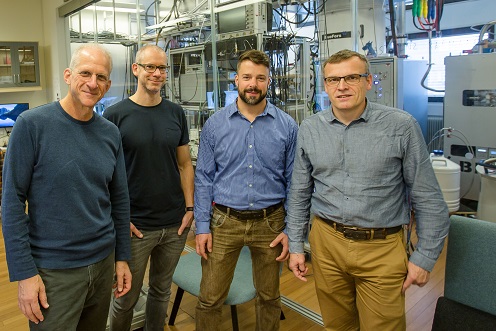Quantum researchers will scrutinize the special qualities of the Majorana particle
For many years, physics has hunted for greater knowledge about elusive particles known as "Majorana particles" with properties fundamentally different from any known particle. Now, researchers from the University of Copenhagen and Lund University have received 10 million euro from the European Research Council, to investigate whether or not the particle holds as great of a potential as hoped for by researchers.

The four grant recipients: Charles Marcus, Martin Leijnse, Ferdinand Kuemmeth and Karsten Flensberg.
The European Research Council Awards has awarded six years of funding for Majorana particle research to a team of physicist at University of Copenhagen and Lund University.
Researchers from around the world aim to employ the laws of quantum mechanics to build devices that can overcome the limits and barriers faced by present day computers. The Majorana particles could potentially play a key role, as they are believed to be superior in storing quantum information.
However, the basic research concerning the physical laws of these new particle needs to be establish before they can be applied to real world electronics.
"The ideal scenario would be for us to verify the Majorana fermion properties in real physical systems. Then we would have made a big step, because discovering and verifying a new type of state of matter is something that can change our fundamental understanding of what nature allows," according to Professor Karsten Flensberg of the University of Copenhagen.
Karsten Flensberg has received the grant along with Ferdinand Kuemmeth, Martin Leijnse, and Charles Marcus. All four are connected to the Center for Quantum Devices at the University of Copenhagen’s Niels Bohr Institute.
Majorana particle is better at storing information
The physicists have received funds for a research project to ascertain whether this unique particle – the Majorana fermion – has the characteristics that researchers expect it does.
Theoretically, Majorana fermion are expected to behave in a specific manner as one exchanges them. When exchanged, the particle changes the entirety of the larger "system" of particles within which it is incorporated. This differs fundamentally from all other known particles, which can only change what happens immediately around them when they are exchanged.
"This is a very special characteristic of a particle known as nonlocality. It could potentially be applied in the processing and protection of quantum information in quantum computers of the future," says Karsten Flensberg.
Must be studied using special superconductors
The precondition for the projects is that NBI researchers successfully develop a new type of superconductor, a type of nanowire which is able to conduct electrons without disturbing them. This will make it possible to study the existence and function of the Majorana particle.
As the superconductor only functions at near absolute zero, experiments must be conducted in a special kind of refrigerator that cools the material to less than a tenth of a degree above the absolute zero of temperature, -273 degrees Celsius. Within this setting, researchers will direct electrical signals to force the Majorana particles to move around and exchange positions. These exchange operations will need to be performed within microseconds, thousands of them in different combinations, to ultimately reveal evidence for or against their predicted unusual exchange statistics.
Contact
Karsten Flensberg
Professor
Niels Bohr Institute
flensberg@nbi.ku.dk
Mobile: +45 25 13 29 69
Nanna Birk
Pressofficer
nbj@science.ku.dk
Mobile: +45 93 51 60 02
Fakta
The ERC Synergy Grant is EUR 10 million, over a six-year period.
The grant recipients are Professor and Center Leader Karsten Flensberg, Associate Professor Ferdinand Kuemmeth, Associate Professor Martin Leijnse, and Professor Charles Marcus, who is also Scientific Director at Microsoft Quantum Lap – Copenhagen. All four are from the Center for Quantum Devices at the University of Copenhagen’s Niels Bohr Institute. Martin Leijnse is employed by Lund University, but also linked to QDev.
Professor Peter Krogstrup, Scientific Director at Microsoft Quantum Materials Lab, and Professor Michael Manfra at Purdue University, USA, will also contributes to the project by growing the special materials needed for the project..
The Center for Quantum Devices is a basic research center funded by the Danish National Research Foundation.
Project title: Foundations of nonlocal and nonabelian condensed-matter systems
